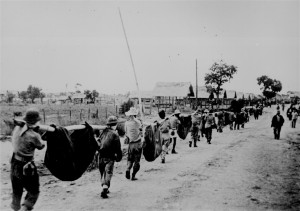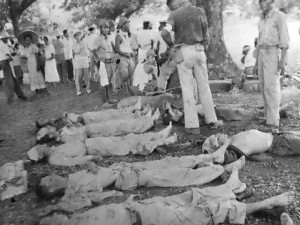No Mama, No Papa, No Uncle Sam
The Bataan Memorial Death March is a challenging march through the high desert terrain of White Sands Missile Range, conducted in honor the the heroic service members who defended the Philippine Island during World War II, sacrificing their freedom, health and in many cases their lives
In April 1942, after General Edward King surrendered the Philippines’ Bataan Peninsula to the Japanese, the largest surrender in U.S. history since the Civil War, almost 800,000 U.S. and Filipino soldiers, after a 98 day siege, were forced to march for 10 days more than 65 miles to an internment camp. The disease ridden and malnourished prisoners were largely denied food and water. Those could keep up were bayoneted, shot for sport or beheaded. By the of the journey, thousands of men had died.
“This picture, captured from the Japanese, shows American prisoners using improvised litters to carry those of their comrades who, from the lack of food or water on the march from Bataan, fell along the road.” Philippines, May 1942. “At the time of its release, this photo was identified as dead and wounded being carried by fellow prisoners during the Bataan Death March in April 1942 … Subsequent information from military archivists, the National Archives and Records Administration, and surviving prisoners, strongly suggests that this photo may actually depict a burial detail at Camp O’Donnell.
 Taken during the March of Death from Bataan to the prison camp march at Cabanatuan. (Defense department USMC 114,540, National Archives). Bataan Death March. Prisoners that died along the way.
Taken during the March of Death from Bataan to the prison camp march at Cabanatuan. (Defense department USMC 114,540, National Archives). Bataan Death March. Prisoners that died along the way.
For today’s march, ten survivors, all in their 90s, were on hand to share their stories. They stood at the start line, on each side of the street, to shake hand as many marches as they could.
